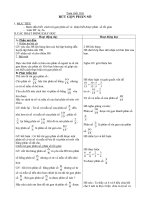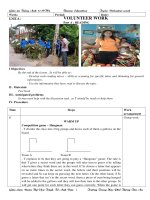Bài soạn Chapter 4 Chemical Quantities and Aqueous Reactions
Bạn đang xem bản rút gọn của tài liệu. Xem và tải ngay bản đầy đủ của tài liệu tại đây (2.4 MB, 107 trang )
Chapter 4
Chemical
Quantities and
Aqueous
Reactions
2011, NKMB Co., Ltd.
Chemistry, Julia Burdge, 2
st
Ed.
McGraw Hill.
Mr. Truong Minh Chien ;
/>
Overview Ch 4
•
Stoichiometry
•
Limiting Reagents
Theoretical Yield
Experimental Yield
•
Molarity
•
Molarity in calculations
•
Electrolytes
•
NIE’s
•
Titrations
•
REDOX
2
3
Reaction Stoichiometry
•
the numerical relationships between chemical amounts
in a reaction is called stoichiometry
•
the coefficients in a balanced chemical equation specify
the relative amounts in moles of each of the substances
involved in the reaction
2 C
8
H
18
(l) + 25 O
2
(g) → 16 CO
2
(g) + 18 H
2
O(g)
2 molecules of C
8
H
18
react with 25 molecules of O
2
to form 16 molecules of CO
2
and 18 molecules of H
2
O
2 moles of C
8
H
18
react with 25 moles of O
2
to form 16 moles of CO
2
and 18 moles of H
2
O
2 mol C
8
H
18
: 25 mol O
2
: 16 mol CO
2
: 18 mol H
2
O
Chemistry, Julia Burdge, 2
nd
e., McGraw Hill.
4
Predicting Amounts from Stoichiometry
•
the amounts of any other substance in a chemical
reaction can be determined from the amount of
just one substance
•
How much CO
2
can be made from 22.0 moles of
C
8
H
18
in the combustion of C
8
H
18
?
2 C
8
H
18
(l) + 25 O
2
(g) → 16 CO
2
(g) + 18 H
2
O(g)
2 moles C
8
H
18
: 16 moles CO
2
2
188
2
188
CO moles 176
HC mol 2
CO mol 16
HC moles 22.0 =×
Chemistry, Julia Burdge, 2
nd
e., McGraw Hill.
5
Example – Estimate the mass of CO
2
produced in
2004 by the combustion of 3.4 x 10
15
g gasoline
•
assuming that gasoline is octane, C
8
H
18
, the equation for
the reaction is:
2 C
8
H
18
(l) + 25 O
2
(g) → 16 CO
2
(g) + 18 H
2
O(g)
•
the equation for the reaction gives the mole relationship
between amount of C
8
H
18
and CO
2
, but we need to know
the mass relationship, so the Concept Plan will be:
g C
8
H
18
mol CO
2
g CO
2
mol C
8
H
18
Chemistry, Julia Burdge, 2
nd
e., McGraw Hill.
Example – Estimate the mass of CO
2
produced in
2004 by the combustion of 3.4 x 10
15
g gasoline
since 8x moles of CO
2
as C
8
H
18
, but the molar mass of C
8
H
18
is
3x CO
2
, the number makes sense
1 mol C
8
H
18
= 114.22g, 1 mol CO
2
= 44.01g, 2 mol C
8
H
18
= 16 mol CO
2
3.4 x 10
15
g C
8
H
18
g CO
2
Check:
Solution:
Concept Plan:
Relationships:
Given:
Find:
g 114.22
mol 1
2
16
2
2
188
2
188
188
188
15
CO g 101.0
CO mol 1
CO g 44.01
HC mol 2
CO mol 16
HC g 114.22
HC mol 1
HC g 10.43
×=
××××
188
2
HC mol 2
CO mol 61
g C
8
H
18
mol CO
2
g CO
2
mol C
8
H
18
mol 1
g 44.01
7
Practice
•
According to the following equation, how
many milliliters of water are made in the
combustion of 9.0 g of glucose?
C
6
H
12
O
6
(s) + 6 O
2
(g) → 6 CO
2
(g) + 6 H
2
O(l)
1. convert 9.0 g of glucose into moles (MM 180)
2. convert moles of glucose into moles of water
3. convert moles of water into grams (MM 18.02)
4. convert grams of water into mL
a) How? what is the relationship between mass and
volume?
density of water = 1.00 g/mL
Chemistry, Julia Burdge, 2
nd
e., McGraw Hill.
8
Practice
OH mL 5.4
OH g 1.00
OH mL 1
x
OH mole 1
OH g 18.0
x
OHC mole 1
OH mole 6
x
g 10 x 80.1
OHC mole 1
x OHC g 0.9
2
2
2
2
2
6126
2
2
6126
6126
=
According to the following equation, how many
milliliters of water are made in the combustion of
9.0 g of glucose?
C
6
H
12
O
6
(s) + 6 O
2
(g) → 6 CO
2
(g) + 6 H
2
O(l)
Chemistry, Julia Burdge, 2
nd
e., McGraw Hill.
9
Limiting Reactant
•
for reactions with multiple reactants, it is likely that one
of the reactants will be completely used before the
others
•
when this reactant is used up, the reaction stops and no
more product is made
•
the reactant that limits the amount of product is called
the limiting reactant
sometimes called the limiting reagent
the limiting reactant gets completely consumed
•
reactants not completely consumed are called excess
reactants
•
the amount of product that can be made from the
limiting reactant is called the theoretical yield
Chemistry, Julia Burdge, 2
nd
e., McGraw Hill.
10
Things Don’t Always Go as Planned!
•
many things can happen during the course of an
experiment that cause the loss of product
•
the amount of product that is made in a reaction
is called the actual yield
generally less than the theoretical yield, never more!
•
the efficiency of product recovery is generally
given as the percent yield
%100
yield ltheoretica
yield actual
YieldPercent
×=
Chemistry, Julia Burdge, 2
nd
e., McGraw Hill.
11
Limiting and Excess Reactants in the
Combustion of Methane
CH
4
(g) + 2 O
2
(g) → CO
2
(g) + 2 H
2
O(g)
•
Our balanced equation for the combustion of methane
implies that every 1 molecule of CH
4
reacts with 2
molecules of O
2
H
H
C
H
H
+
O
O
C
+
OO
OO
+
O
H H
O
H H
+
Chemistry, Julia Burdge, 2
nd
e., McGraw Hill.
12
Limiting and Excess Reactants in the
Combustion of Methane
•
If we have 5 molecules of CH
4
and 8 molecules
of O
2
, which is the limiting reactant?
H
H
C
H
H
+
OO
OO
OO
OO
OO
OO
OO
OO
?
H
H
C
H
H
H
H
C
H
H
H
H
C
H
H
H
H
C
H
H
CH
4
(g) + 2 O
2
(g) → CO
2
(g) + 2 H
2
O(g)
13
Limiting and Excess Reactants in the
Combustion of Methane
H
H
C
H
H
H
H
C
H
H
+
OO
OO
OO
OO
OO
OO
OO
OO
H
H
C
H
H
H
H
C
H
H
H
H
C
H
H
2
4
2
4
CO molecules 16
CH molecules 1
CO molecules 2
CH molecules 8 =×
CH
4
(g) + 2 O
2
(g) → CO
2
(g) + 2 H
2
O(g)
2
2
2
2
CO molecules 10
O molecules 2
CO molecules 2
O molecules 10 =×
since less CO
2
can be made
from the O
2
than
the CH
4
, the O
2
is the limiting
reactant
Example 4.4
Finding Limiting Reactant,
Theoretical Yield, and
Percent Yield
Tro, Chemistry: A Molecular Approach 15
Example:
•
When 28.6 kg of C are allowed to react with 88.2 kg of
TiO
2
in the reaction below, 42.8 kg of Ti are obtained.
Find the Limiting Reactant, Theoretical Yield, and Percent
Yield.
(g)(s)(s)(s) CO 2 Ti C 2 TiO
2
+→+
Tro, Chemistry: A Molecular Approach 16
Example:
When 28.6 kg of C reacts with 88.2
kg of TiO
2
, 42.8 kg of Ti are
obtained. Find the Limiting
Reactant, Theoretical Yield, and
Percent Yield.
TiO
2
(s) + 2 C(s) → Ti(s) + 2 CO(g)
•
Write down the given quantity and its units.
Given: 28.6 kg C
88.2 kg TiO
2
42.8 kg Ti produced
Tro, Chemistry: A Molecular Approach 17
•
Write down the quantity to find and/or its units.
Find: limiting reactant
theoretical yield
percent yield
Example:
Find the Limiting
Reactant, Theoretical
Yield, and Percent Yield.
TiO
2
(s) + 2 C(s) →
Ti(s) + 2 CO(g)
Information
Given: 28.6 kg C, 88.2 kg TiO
2
, 42.8 kg Ti
18
•
Write a Concept Plan:
Information
Given: 28.6 kg C, 88.2 kg TiO
2
, 42.8 kg Ti
Find: Lim. Rct., Theor. Yld., % Yld.
Example:
Find the Limiting
Reactant, Theoretical
Yield, and Percent Yield.
TiO
2
(s) + 2 C(s) →
Ti(s) + 2 CO(g)
kg
TiO
2
kg
C
2
2
TiO g 9.877
TiO mol 1
C g .0112
C mol 1
mol
C
mol
TiO
2
mol
Ti
mol
Ti
2
TiO mol 1
Ti mol 1
C mol 2
Ti mol 1
}
smallest
amount is
from
limiting
reactant
g
TiO
2
g
C
kg 1
g 1000
kg 1
g 1000
smallest
mol Ti
g Ti
Ti mol 1
g 87.47
% Yield
yield theor.
yield act.
yield % =
kg Ti
T.Y.
g 000 1
kg 1
19
•
Collect Needed Relationships:
1000 g = 1 kg
Molar Mass TiO
2
= 79.87 g/mol
Molar Mass Ti = 47.87 g/mol
Molar Mass C = 12.01 g/mol
1 mole TiO
2
: 1 mol Ti (from the chem. equation)
2 mole C ≡ 1 mol Ti (from the chem. equation)
Information
Given: 28.6 kg C, 88.2 kg TiO
2
, 42.8 kg Ti
Find: Lim. Rct., Theor. Yld., % Yld.
CP: kg rct → g rct → mol rct → mol Ti
pick smallest mol Ti → TY kg Ti → %Y Ti
Example:
Find the Limiting
Reactant, Theoretical
Yield, and Percent Yield.
TiO
2
(s) + 2 C(s) →
Ti(s) + 2 CO(g)
Tro, Chemistry: A Molecular Approach 20
Ti mol 104301.1
TiO mol 1
Ti mol 1
TiO g 79.87
TiO mole 1
kg 1
g 0001
TiO kg 8.28
3
22
2
2
×=×××
•
Apply the Concept Plan:
Information
Given: 28.6 kg C, 88.2 kg TiO
2
, 42.8 kg Ti
Find: Lim. Rct., Theor. Yld., % Yld.
CP: kg rct → g rct → mol rct → mol Ti
pick smallest mol Ti → TY kg Ti → %Y Ti
Rel: 1 mol C=12.01g; 1 mol Ti =47.87g;
1 mol TiO
2
= 79.87g; 1000g = 1 kg;
1 mol TiO
2
: 1 mol Ti; 2 mol C : 1 mol Ti
Example:
Find the Limiting
Reactant, Theoretical
Yield, and Percent
Yield.
TiO
2
(s) + 2 C(s) →
Ti(s) + 2 CO(g)
Ti mol 100791.1
C mol 2
Ti mol 1
C g 12.01
C mole 1
kg 1
g 0001
C kg 8.62
3
×=×××
smallest moles of Ti
Limiting Reactant
Tro, Chemistry: A Molecular Approach 21
•
Apply the Concept Plan:
Ti kg 52.9
g 1000
kg 1
mol 1
Ti g 47.87
Ti mol 104301.1
3
=×××
Theoretical Yield
Information
Given: 28.6 kg C, 88.2 kg TiO
2
, 42.8 kg Ti
Find: Lim. Rct., Theor. Yld., % Yld.
CP: kg rct → g rct → mol rct → mol Ti
pick smallest mol Ti → TY kg Ti → %Y Ti
Rel: 1 mol C=12.01g; 1 mol Ti =47.87g;
1 mol TiO
2
= 79.87g; 1000g = 1 kg;
1 mol TiO
2
: 1 mol Ti; 2 mol C : 1 mol Ti
Example:
Find the Limiting
Reactant, Theoretical
Yield, and Percent
Yield.
TiO
2
(s) + 2 C(s) →
Ti(s) + 2 CO(g)
Tro, Chemistry: A Molecular Approach 22
•
Apply the Concept Plan:
YieldPercent 100
Yield lTheoretica
Yield Actual
=×
%
%9.08%100
Ti kg 52.9
Ti kg 42.8
=×
Information
Given: 28.6 kg C, 88.2 kg TiO
2
, 42.8 kg Ti
Find: Lim. Rct., Theor. Yld., % Yld.
CP: kg rct → g rct → mol rct → mol Ti
pick smallest mol Ti → TY kg Ti → %Y Ti
Rel: 1 mol C=12.01g; 1 mol Ti =47.87g;
1 mol TiO
2
= 79.87g; 1000g = 1 kg;
1 mol TiO
2
: 1 mol Ti; 2 mol C : 1 mol Ti
Example:
Find the Limiting
Reactant, Theoretical
Yield, and Percent
Yield.
TiO
2
(s) + 2 C(s) →
Ti(s) + 2 CO(g)
Tro, Chemistry: A Molecular Approach 23
•
Check the Solutions:
Limiting Reactant = TiO
2
Theoretical Yield = 52.9 kg
Percent Yield = 80.9%
Since Ti has lower molar mass than TiO
2
, the T.Y. makes sense
The Percent Yield makes sense as it is less than 100%.
Information
Given: 28.6 kg C, 88.2 kg TiO
2
, 42.8 kg Ti
Find: Lim. Rct., Theor. Yld., % Yld.
CP: kg rct → g rct → mol rct → mol Ti
pick smallest mol Ti → TY kg Ti → %Y Ti
Rel: 1 mol C=12.01g; 1 mol Ti =47.87g;
1 mol TiO
2
= 79.87g; 1000g = 1 kg;
1 mol TiO
2
: 1 mol Ti; 2 mol C : 1 mol Ti
Example:
Find the Limiting
Reactant, Theoretical
Yield, and Percent
Yield.
TiO
2
(s) + 2 C(s) →
Ti(s) + 2 CO(g)
Tro, Chemistry: A Molecular Approach 24
Practice – How many grams of N
2
(g) can be made from
9.05 g of NH
3
reacting with 45.2 g of CuO?
2 NH
3
(g) + 3 CuO(s) → N
2
(g) + 3 Cu(s) + 3 H
2
O(l)
Practice – How many grams of N
2
(g) can be made from 9.05 g of
NH
3
reacting with 45.2 g of CuO?
2 NH
3
(g) + 3 CuO(s) → N
2
(g) + 3 Cu(s) + 3 H
2
O(l)
1 mol NH
3
= 17.03g, 1 mol CuO = 79.55g, 1 mol N
2
= 28.02 g
2 mol NH
3
= 1 mol N
2
, 3 mol CuO = 1 mol N
2
9.05 g NH
3
, 45.2 g CuO
g N
2
Concept Plan:
Relationships:
Given:
Find:
g 17.03
mol 1
3
2
NH mol 2
N mol 1
g NH
3
mol N
2
mol NH
3
g 28.02
mol 1
g CuO
mol N
2
mol CuO
CuO mol 3
N mol 1
2
g 79.55
mol 1
g N
2
smallest moles N
2









